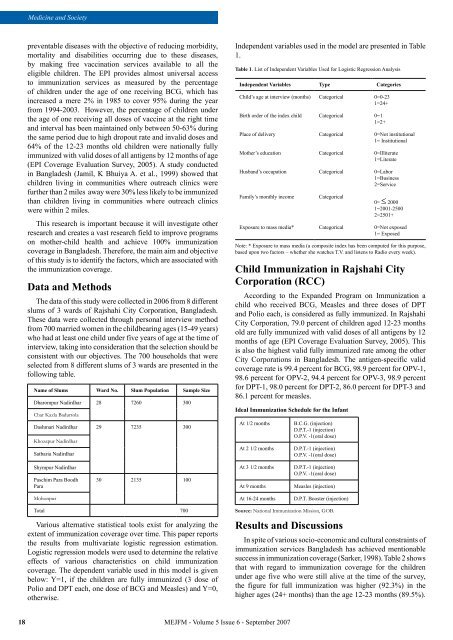Contents - Middle East Journal of Family Medicine
Contents - Middle East Journal of Family Medicine
Contents - Middle East Journal of Family Medicine
- No tags were found...
You also want an ePaper? Increase the reach of your titles
YUMPU automatically turns print PDFs into web optimized ePapers that Google loves.
<strong>Medicine</strong> and Society<br />
preventable diseases with the objective <strong>of</strong> reducing morbidity,<br />
mortality and disabilities occurring due to these diseases,<br />
by making free vaccination services available to all the<br />
eligible children. The EPI provides almost universal access<br />
to immunization services as measured by the percentage<br />
<strong>of</strong> children under the age <strong>of</strong> one receiving BCG, which has<br />
increased a mere 2% in 1985 to cover 95% during the year<br />
from 1994-2003. However, the percentage <strong>of</strong> children under<br />
the age <strong>of</strong> one receiving all doses <strong>of</strong> vaccine at the right time<br />
and interval has been maintained only between 50-63% during<br />
the same period due to high dropout rate and invalid doses and<br />
64% <strong>of</strong> the 12-23 months old children were nationally fully<br />
immunized with valid doses <strong>of</strong> all antigens by 12 months <strong>of</strong> age<br />
(EPI Coverage Evaluation Survey, 2005). A study conducted<br />
in Bangladesh (Jamil, K Bhuiya A. et al., 1999) showed that<br />
children living in communities where outreach clinics were<br />
further than 2 miles away were 30% less likely to be immunized<br />
than children living in communities where outreach clinics<br />
were within 2 miles.<br />
This research is important because it will investigate other<br />
research and creates a vast research field to improve programs<br />
on mother-child health and achieve 100% immunization<br />
coverage in Bangladesh. Therefore, the main aim and objective<br />
<strong>of</strong> this study is to identify the factors, which are associated with<br />
the immunization coverage.<br />
Data and Methods<br />
The data <strong>of</strong> this study were collected in 2006 from 8 different<br />
slums <strong>of</strong> 3 wards <strong>of</strong> Rajshahi City Corporation, Bangladesh.<br />
These data were collected through personal interview method<br />
from 700 married women in the childbearing ages (15-49 years)<br />
who had at least one child under five years <strong>of</strong> age at the time <strong>of</strong><br />
interview, taking into consideration that the selection should be<br />
consistent with our objectives. The 700 households that were<br />
selected from 8 different slums <strong>of</strong> 3 wards are presented in the<br />
following table.<br />
Name <strong>of</strong> Slums Ward No. Slum Population Sample Size<br />
Dharompur Nadirdhar 28 7260 300<br />
Char Kazla Badurtola<br />
Dashmari Nadirdhar 29 7235 300<br />
Khozapur Nadirdhar<br />
Satbaria Nadirdhar<br />
Independent variables used in the model are presented in Table<br />
1.<br />
Table 1. List <strong>of</strong> Independent Variables Used for Logistic Regression Analysis<br />
Independent Variables Type Categories<br />
Child’s age at interview (months) Categorical 0=0-23<br />
1=24+<br />
Birth order <strong>of</strong> the index child Categorical 0=1<br />
1=2+<br />
Place <strong>of</strong> delivery Categorical 0=Not institutional<br />
1= Institutional<br />
Mother’s education Categorical 0=Illiterate<br />
1=Literate<br />
Husband’s occupation Categorical 0=Labor<br />
1=Business<br />
2=Service<br />
<strong>Family</strong>’s monthly income<br />
Categorical<br />
0= ≤ 2000<br />
1=2001-2500<br />
2=2501+<br />
Exposure to mass media* Categorical 0=Not exposed<br />
1= Exposed<br />
Note: * Exposure to mass media (a composite index has been computed for this purpose,<br />
based upon two factors – whether she watches T.V. and listens to Radio every week).<br />
Child Immunization in Rajshahi City<br />
Corporation (RCC)<br />
According to the Expanded Program on Immunization a<br />
child who received BCG, Measles and three doses <strong>of</strong> DPT<br />
and Polio each, is considered as fully immunized. In Rajshahi<br />
City Corporation, 79.0 percent <strong>of</strong> children aged 12-23 months<br />
old are fully immunized with valid doses <strong>of</strong> all antigens by 12<br />
months <strong>of</strong> age (EPI Coverage Evaluation Survey, 2005). This<br />
is also the highest valid fully immunized rate among the other<br />
City Corporations in Bangladesh. The antigen-specific valid<br />
coverage rate is 99.4 percent for BCG, 98.9 percent for OPV-1,<br />
98.6 percent for OPV-2, 94.4 percent for OPV-3, 98.9 percent<br />
for DPT-1, 98.0 percent for DPT-2, 86.0 percent for DPT-3 and<br />
86.1 percent for measles.<br />
Ideal Immunization Schedule for the Infant<br />
At 1/2 months<br />
At 2 1/2 months<br />
B.C.G. (injection)<br />
D.P.T.-1 (injection)<br />
O.P.V. -1(oral dose)<br />
D.P.T.-1 (injection)<br />
O.P.V. -1(oral dose)<br />
Shympur Nadirdhar<br />
Paschim Para Boodh<br />
Para<br />
30 2135 100<br />
At 3 1/2 months<br />
At 9 months<br />
D.P.T.-1 (injection)<br />
O.P.V. -1(oral dose)<br />
Measles (injection)<br />
Mohonpur<br />
At 16-24 months<br />
D.P.T. Booster (injection)<br />
Total 700<br />
Various alternative statistical tools exist for analyzing the<br />
extent <strong>of</strong> immunization coverage over time. This paper reports<br />
the results from multivariate logistic regression estimation.<br />
Logistic regression models were used to determine the relative<br />
effects <strong>of</strong> various characteristics on child immunization<br />
coverage. The dependent variable used in this model is given<br />
below: Y=1, if the children are fully immunized (3 dose <strong>of</strong><br />
Polio and DPT each, one dose <strong>of</strong> BCG and Measles) and Y=0,<br />
otherwise.<br />
Source: National Immunization Mission, GOB.<br />
Results and Discussions<br />
In spite <strong>of</strong> various socio-economic and cultural constraints <strong>of</strong><br />
immunization services Bangladesh has achieved mentionable<br />
success in immunization coverage (Sarker, 1998). Table 2 shows<br />
that with regard to immunization coverage for the children<br />
under age five who were still alive at the time <strong>of</strong> the survey,<br />
the figure for full immunization was higher (92.3%) in the<br />
higher ages (24+ months) than the age 12-23 months (89.5%).<br />
18<br />
MEJFM - Volume 5 Issue 6 - September 2007
















